No matter the purpose of owning your Griswold cast iron items, there are certain facts you need to be aware of. First of all, they are highly valuable, collectible, and rare. That makes this particular cookware highly desirable for real collectors and American history lovers. Believe it or not, its history goes back to the 19th century when many kitchen items were handmade.
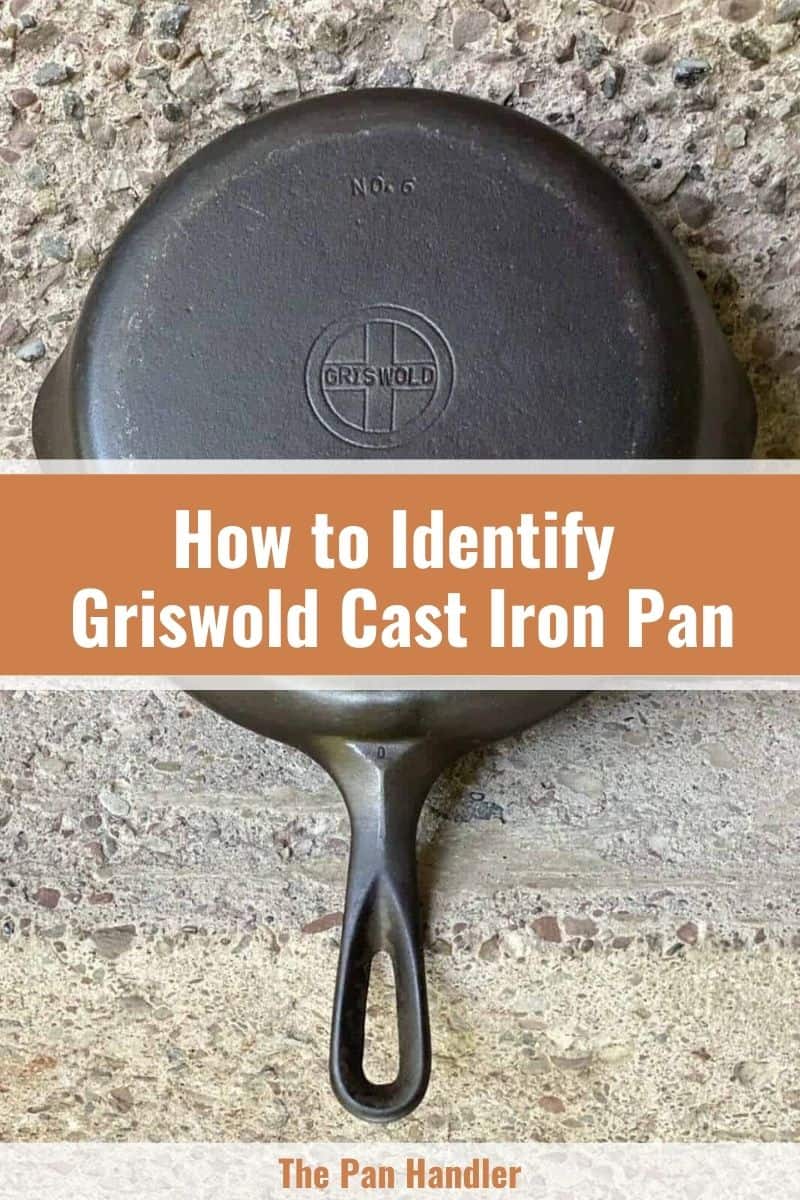
Since these pieces are of high quality, have a good reputation, and century-long durability, many chefs, cooks, and housewives still prepare their meals in Griswold cast iron cooking dishes. Most of them refuse to replace them with contemporary cooking equipment because they disapprove of the theory that modern is better. Let’s discover the reason for their attitude.
This article will cover
- History of Griswold Cast Iron.
- Date Griswold Skillet with Logos.
- Markings.
- Purpose of Griswold Cast Iron.
- Types of Griswold Cast Iron Cooking Items.
- Sizing of Griswold Cast Iron Cooking Items.
Quick Summary: Griswold Cast Iron Markings
1. Griswold cast iron skillet with Erie logo 1880-1907 | 2. Griswold cast iron with Diamond logo 1905-1906 | 3. Griswold Slant Logo with heat ring and no EPU 1906-1916 |
4. Griswold Slant logo with EPU and heat ring 1906-1926 | 5. Griswold Slant logo cast iron without Erie 1909-1920 | 6. Large block logo with heat ring and no italic lettering 1920-1930 |
7. Large block logo without heat ring and italic lettering 1930-1939 | 8. Griswold Large slant logo without heat ring 1939-1944 | 9. Griswold cast iron with Small block logo 1939-1957 |
History of Griswold Cast Iron
The origin of Griswold cookware dates back to 1865 when the Selden and Griswold families from Pennsylvania transformed a small family-run factory into a new business.
The founders were Matthew Griswold and his cousins J.C and Samuel Selden. In the beginning, they made door hinges. Soon after, in the 1870s, they expanded their business to dishes, which became the most respectful iron cast cookware all over the world very soon.
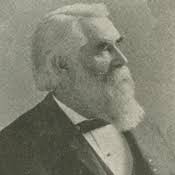
Since the original factory established in Erie, Pennsylvania, most cooking items you can find on the market have an ERIE mark at the bottom. In fact, the ERIE logo was the first one that they used for their cookware.
After Matthew Griswold paid off the Selden family in 1884, a horrible fire devastated the factory. Without hesitation, Mr. Griswold rebuilt the facilities and called the new business Griswold Manufacturing Company. Since then, it became very successful and got the status of one of the most respected companies for cast iron production in the US.
The overall success and accomplishments of this company lasted until 1957. From the founding to that moment, the Griswold Manufacturing Company supplied the Americans with a significant amount of most elegant iron casts pans, pots, waffle irons, and many other cooking pieces of equipment.
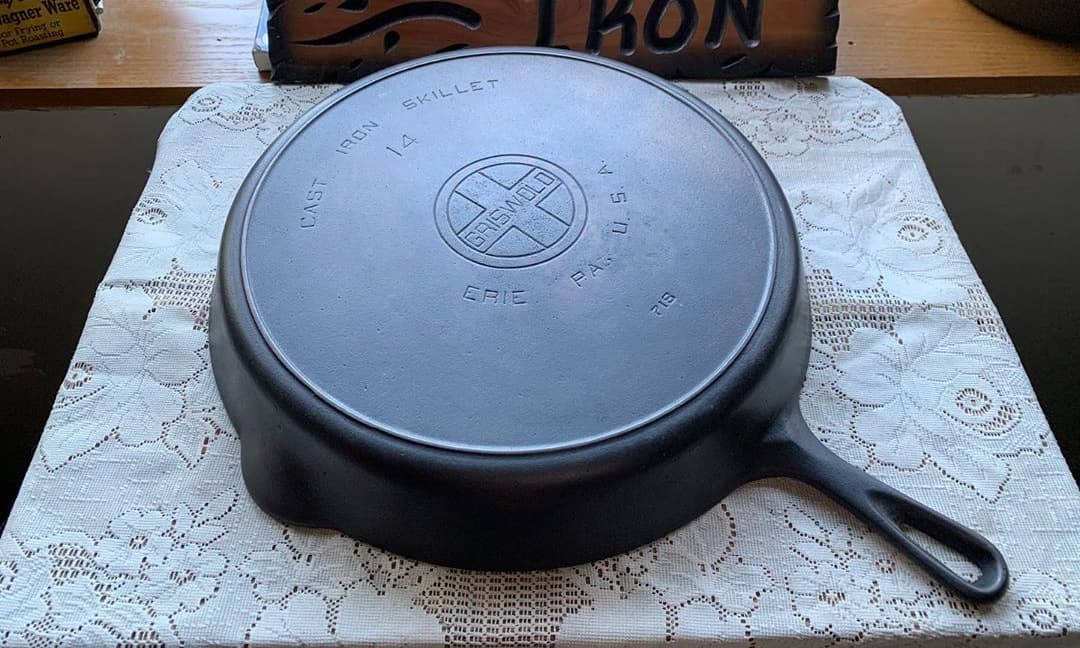
Date Griswold Skillet with Logos
As the company grew and changed throughout the time, the logos and markings on the skillets, pots, and other cookware also changed. Although markings can be a bit confusing, logos are pretty straightforward, and you can connect them to years of manufacturing. Thus, they give us an accurate time perspective of the products this company made over time.
1. Griswold Cast Iron Erie logo (1880-1907)
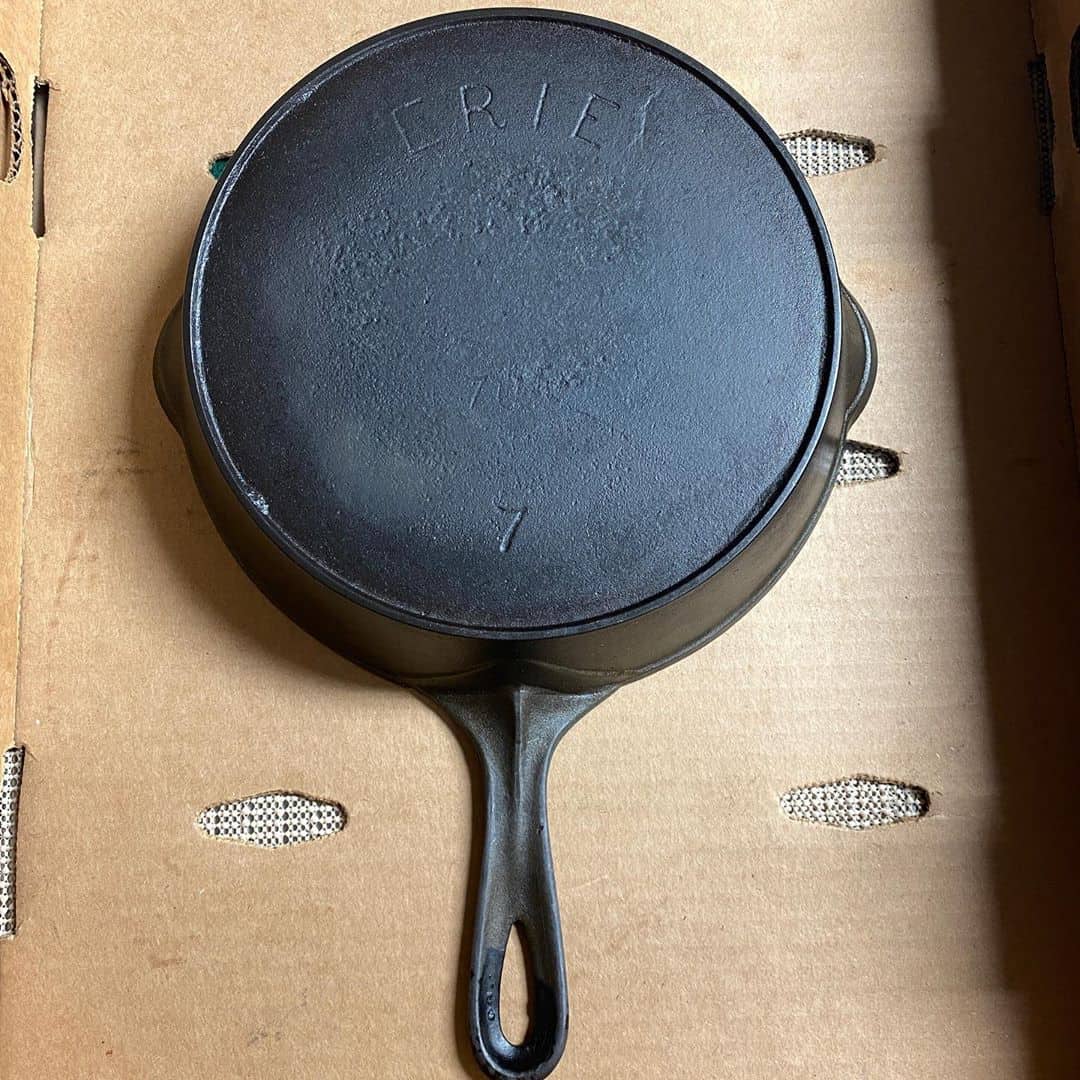
As I have already mentioned, the ERIE logo was the first, and we can connect it with a period from 1880 to 1907. Many collectors love the first phase of iron cast cookware production, and they are willing to give a lot of money for items made in that period.
2. Griswold diamond logo (1905-1906)
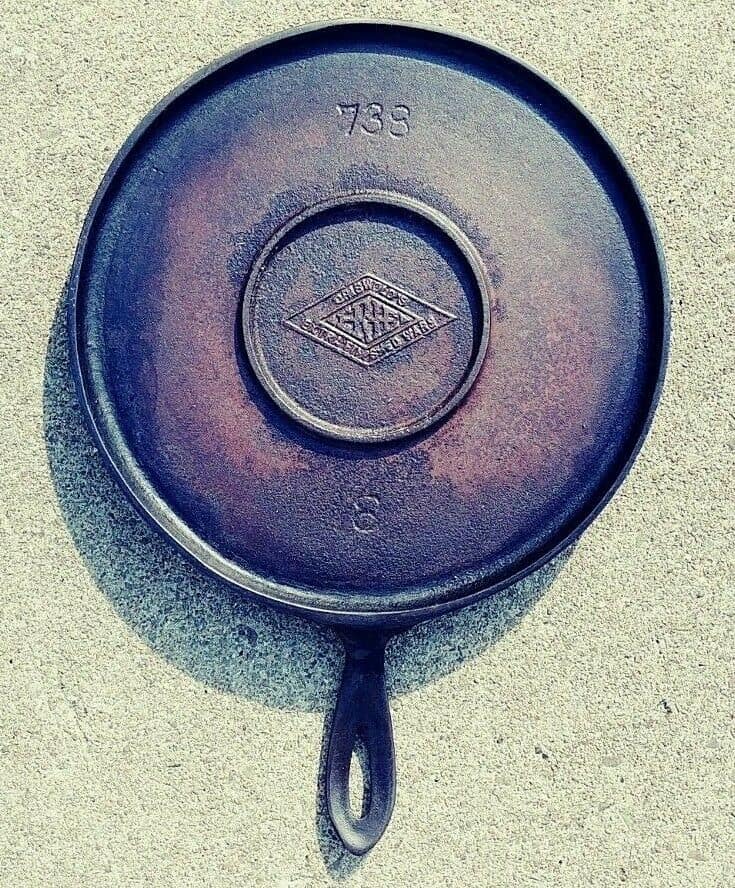
Next in line is Griswold Erie, well-known as the Griswold diamond logo. It was in use for only one year, and you can find it on cookware made from 1905 to 1906. Therefore, the items from that period are highly valuable and collectible.
3. Griswold Slant Logo with heat ring and no EPU (1906-1916)
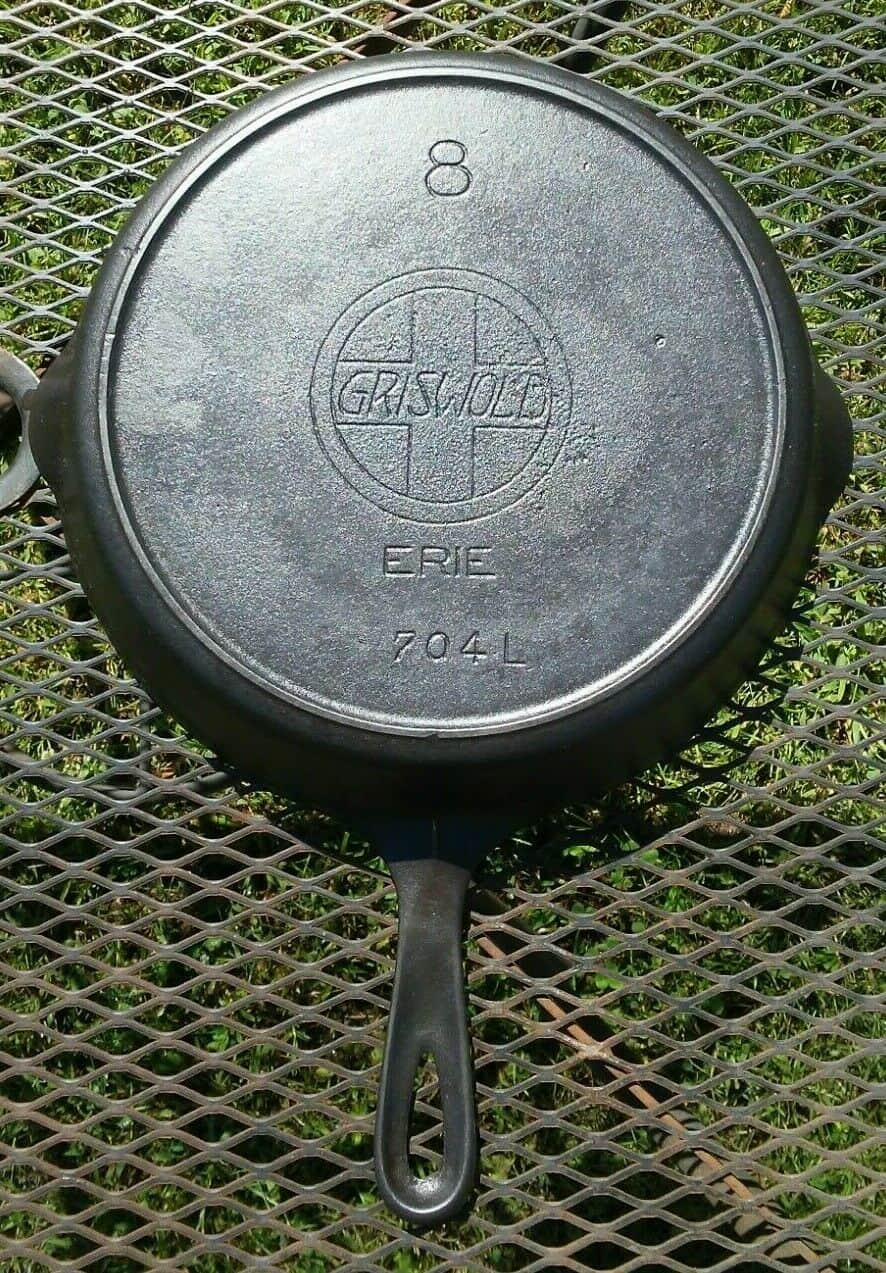
The new change came from 1906 to 1916 when the items got a new look and famous circle-cross Slant Logo. The cross in the circle was printed on the dishes over a long period, while the ERIE sign appeared at only a limited series of skillets and pots.
4. Griswold Slant logo with EPU and heat ring (1906-1926)
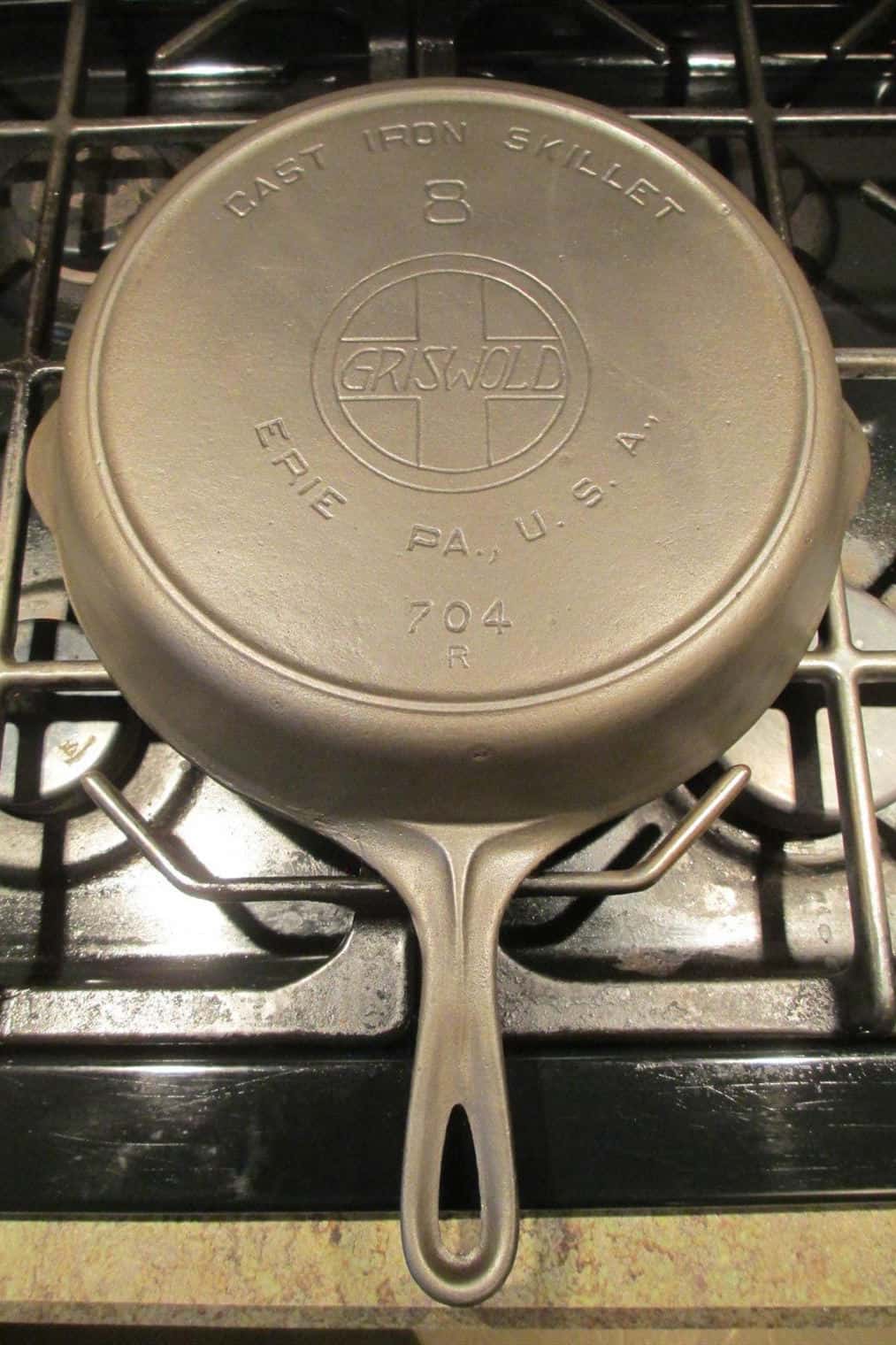
It was not unusual that some logos overlapped in that period. Therefore, you can find another Slant Logo with EPU in the period from 1906 to 1926. The EPU is short for Erie, Pennsylvania, USA. Until then, all the logos had the sign Erie, PA, USA, but from then on, they got the short version EPU.
5. Griswold Slant logo without Erie (1909-1920)
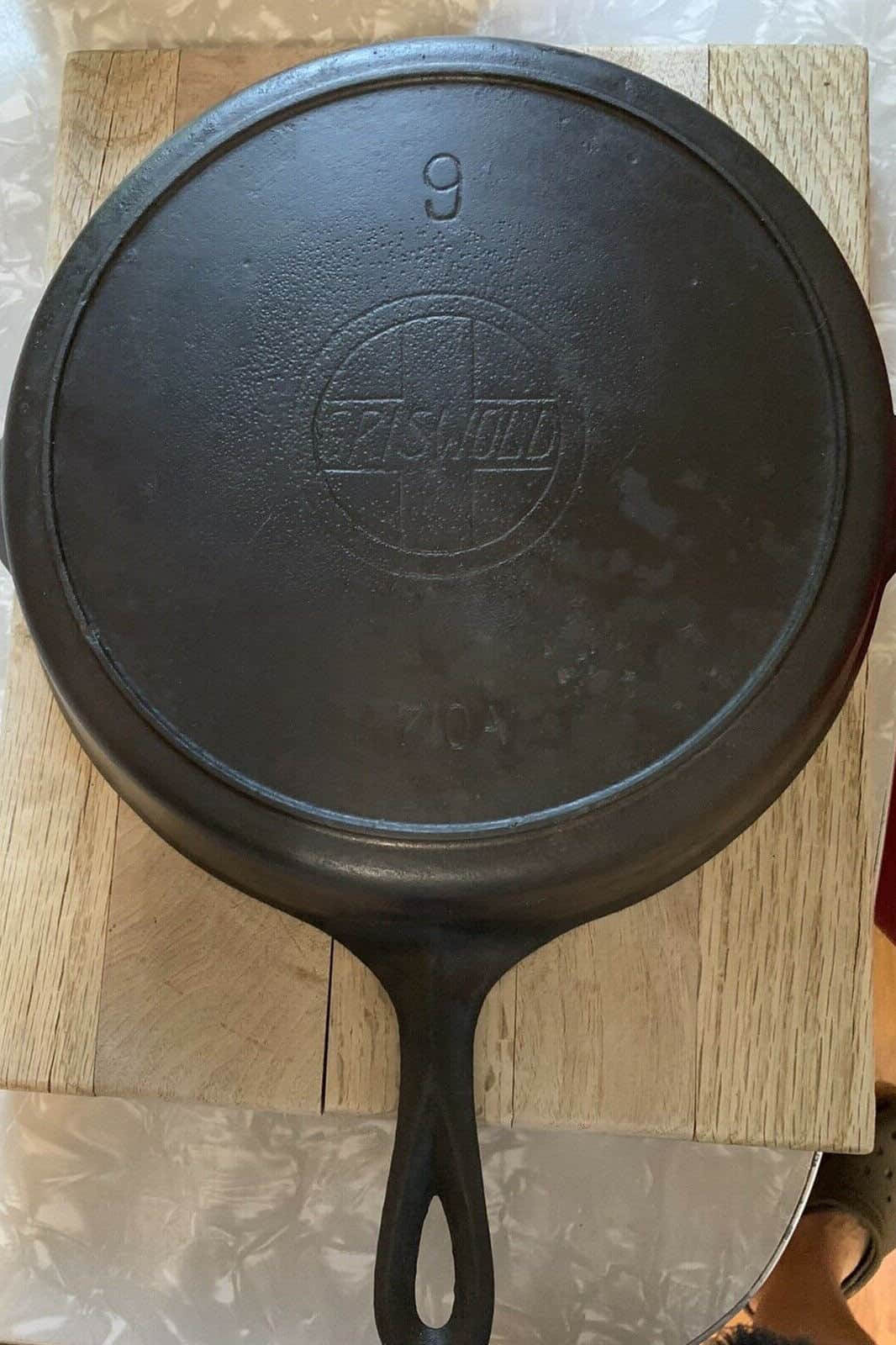
The change came once again in the period from 1909 to 1920. In that period, the company printed logos on the bottom without the Erie sign. As you can see, that was the third variation for the same period.
6. Griswold Large block logo with heat ring and no italic lettering (1920-1930)
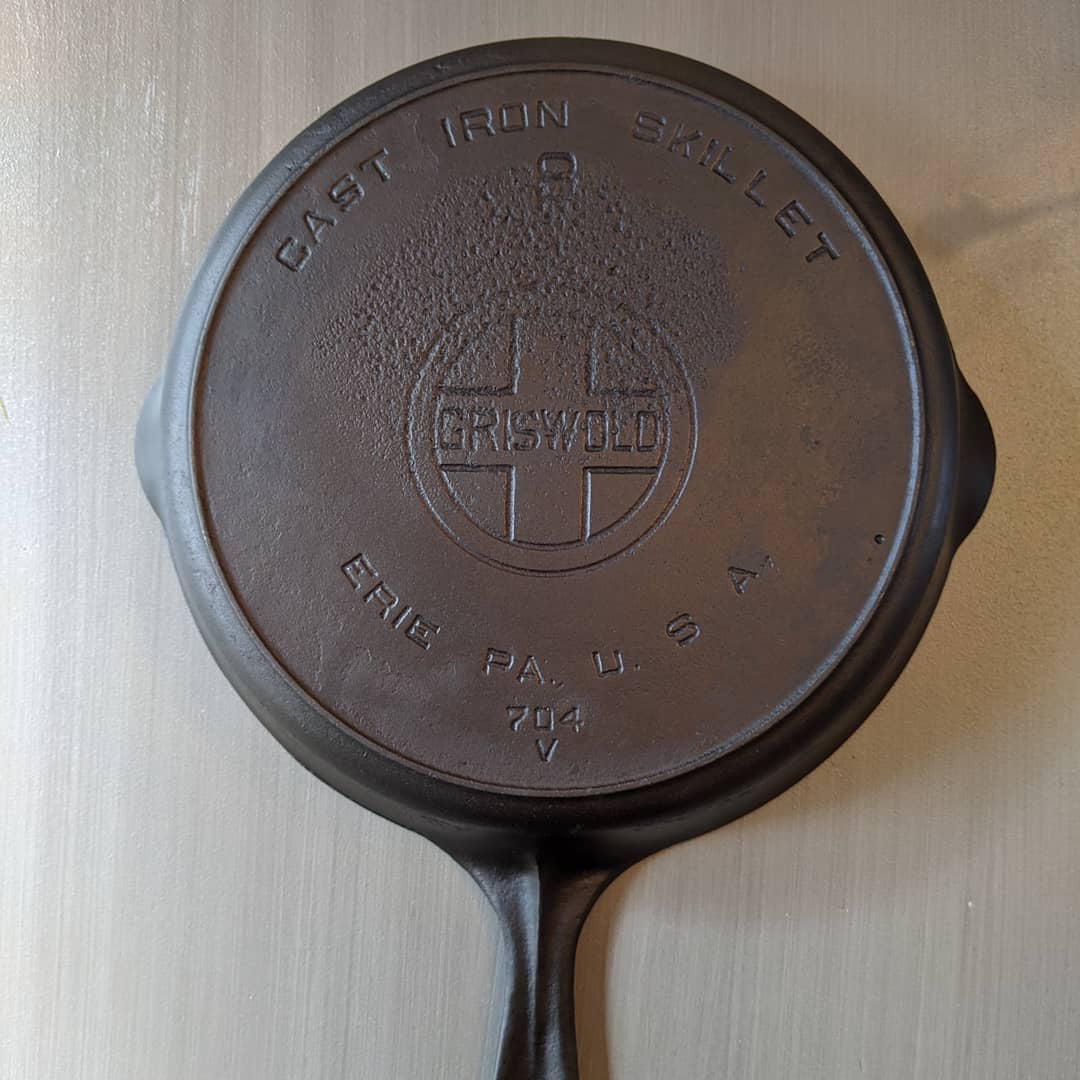
From 1920 to 1939, people could find cookware with a large block logo and two different markings. The one from 1920 to 1930 didn’t contain italic lettering.
7. Large block logo without heat ring and italic lettering (1930-1939)
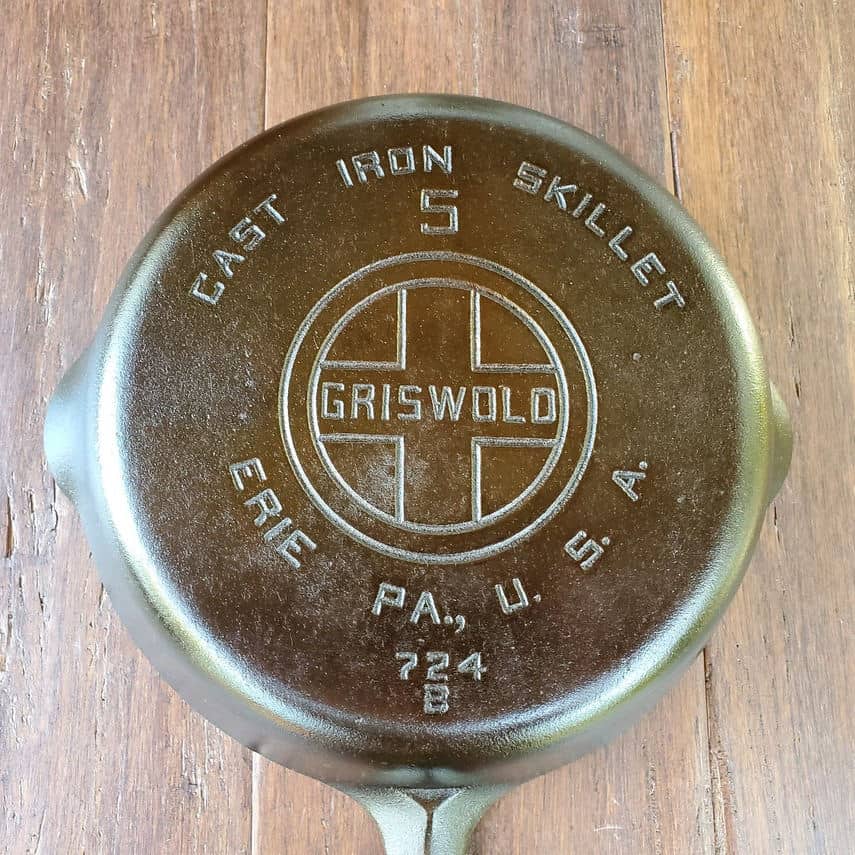
The other was circa large block logo from 1930 to 1939. Somewhere in that period, the large block logo on the cookware without a heat ring appeared. Don’t worry if you have one of those. It is not fake but just another crazy variation.
8. Griswold Large slant logo without heat ring (1939-1944)
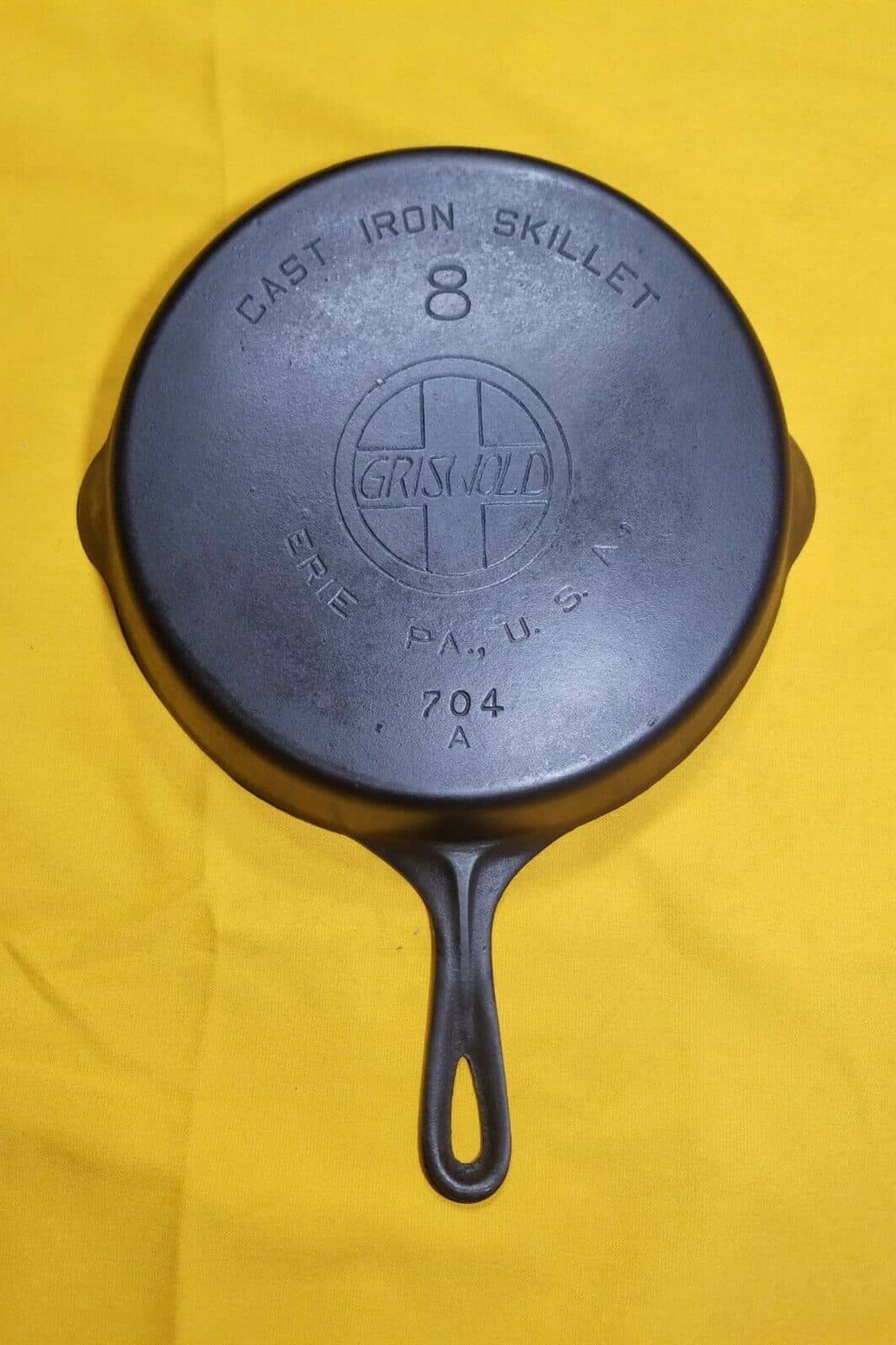
Large slant logo Griswold appeared somewhere between 1939 and 1944. The difference from other cookware was that they didn’t have a heat ring.
9. Small block logo Griswold (1939-1957)
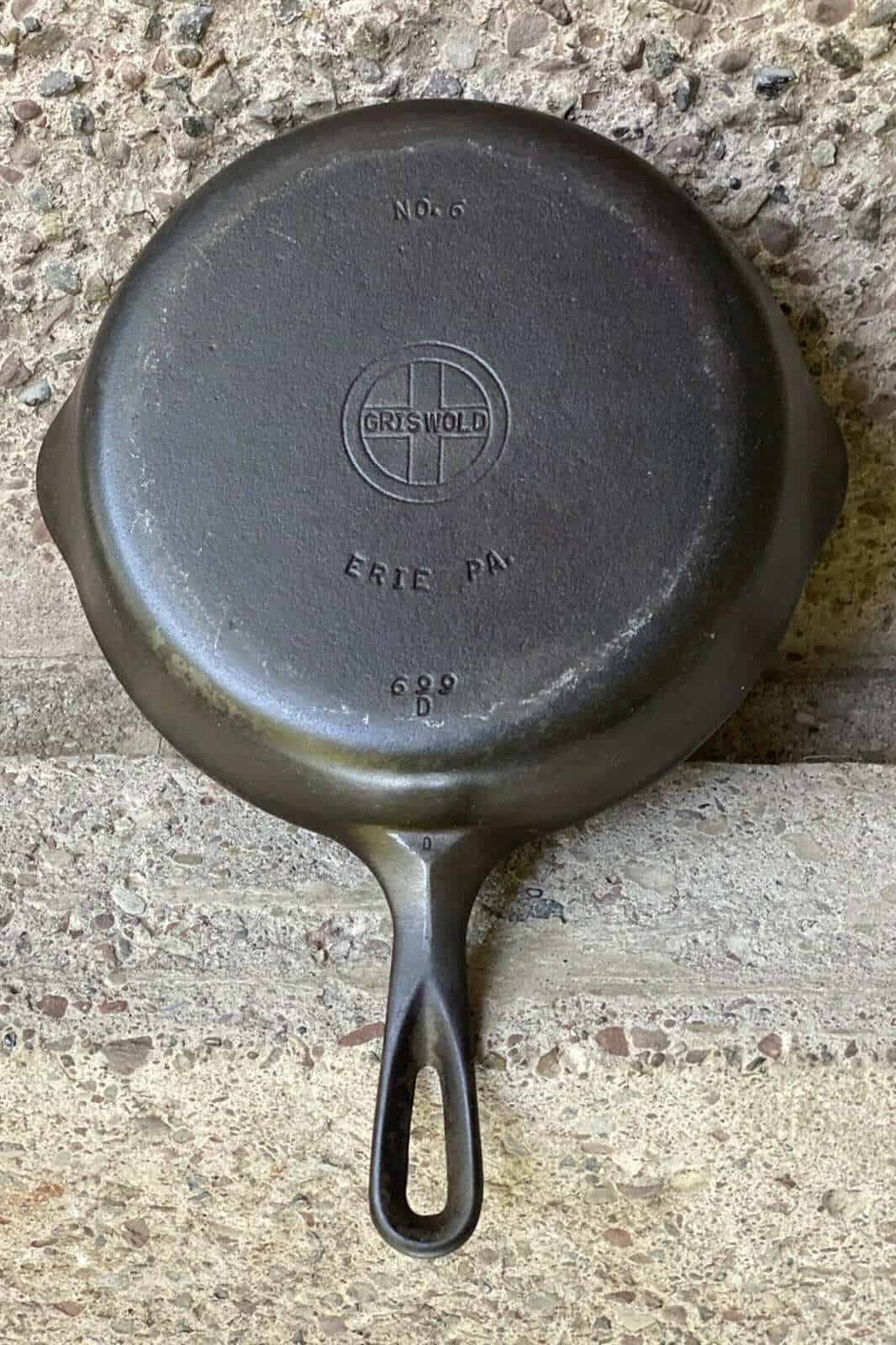
The last one is the small block logo. It was characteristic of Griswold iron cast cookware made in the period from 1939 to 1957.
Markings
Apart from logos, the Griswold iron cast pans and cooking items changed markings over time. Many experts and collectors agreed that they were not essential as they were part of the factory’s molds. They were not connected with the quality or uniqueness of the products.
Marks represented information about manufacturing. Thanks to them, you can determine how many items were made by the same worker, the number of molds, and the makings of different pots.
For example, AS was the mark for All-Star Pan, CF for Chicken Fryer, CK for Country Kettle, SK for Skillet, SP for Sauce Pan or Stew Pan, and so on.
Purpose of Griswold Cast Iron
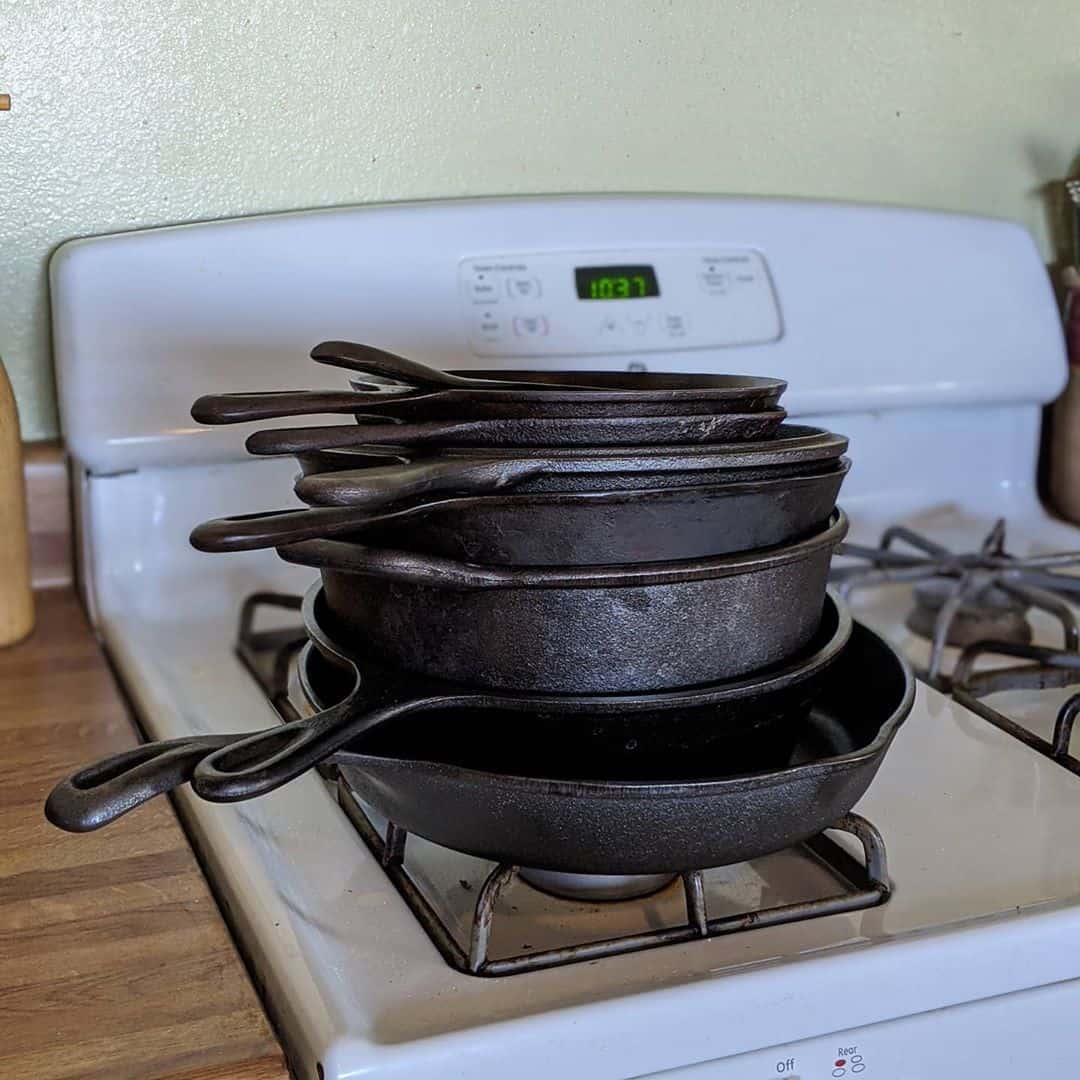
Cooking at high temperatures is sometimes crucial to get crispy and crunch food. Griswold cast iron cookware can withstand high temperatures for a long time, and you can’t cool them down quickly. That means the frying oil will stay hot inside these dishes for a long time.
Even though you add some cold oil or liquid in their cast iron pan, you won’t be able to lower the temperature for a while. That way, you will save more energy than by using any other fry pan.
The advantage of these models is that they are far lighter than cast iron pans produced nowadays. Every experienced cooking expert will tell you how essential it is for the skillet to be light and practical. Since you need to make many moves and hold it in one hand while cooking, you will get tired soon if it is too heavy.
In the past, people were more practical as they had small kitchens, or they often moved from one place to another. That is why the Griswold pans were a bit deeper, and people used them as a fry pan and cooking pot at the same time. Nowadays, we can’t pack our modern households in just one cart. It is unbelievable, isn’t it?
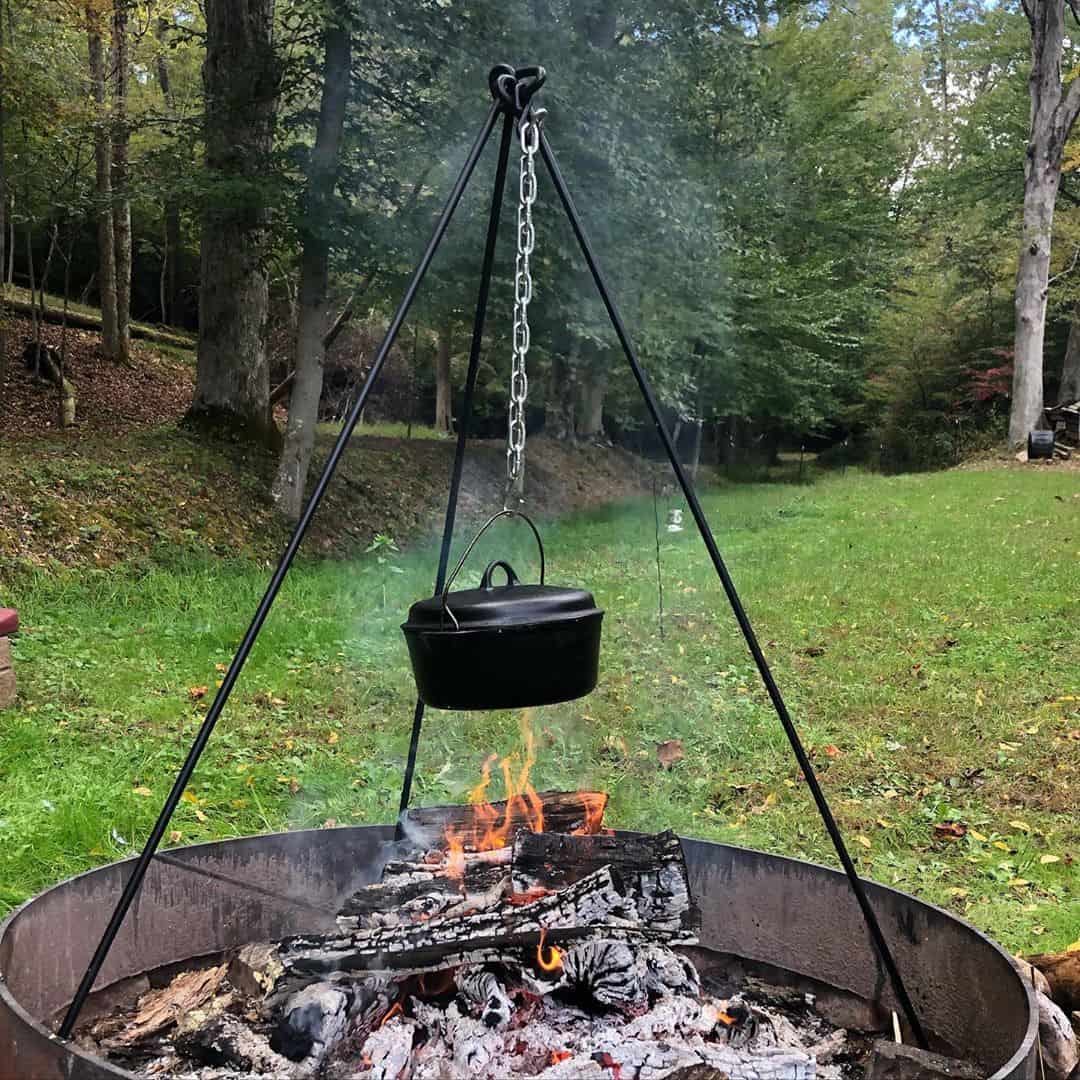
Furthermore, the Griswold company was making pots, pans, and other items to match all kinds of heat sources. You can use them for cooking your meal on an open fire, on the electric burner, or an old-fashioned wood stove.
Keep in mind that the old-fashioned woodstoves used to have openings, and people could fit Griswold iron cast cookware there to cook food on an open fire. Also, these dishes were convenient for preparing food on a grill.
For all those reasons, you shouldn’t throw away the old Griswold cast iron pans if you have any. They can last in your family for generations if appropriately maintained.
Types of Griswold Cast Iron Cooking Items
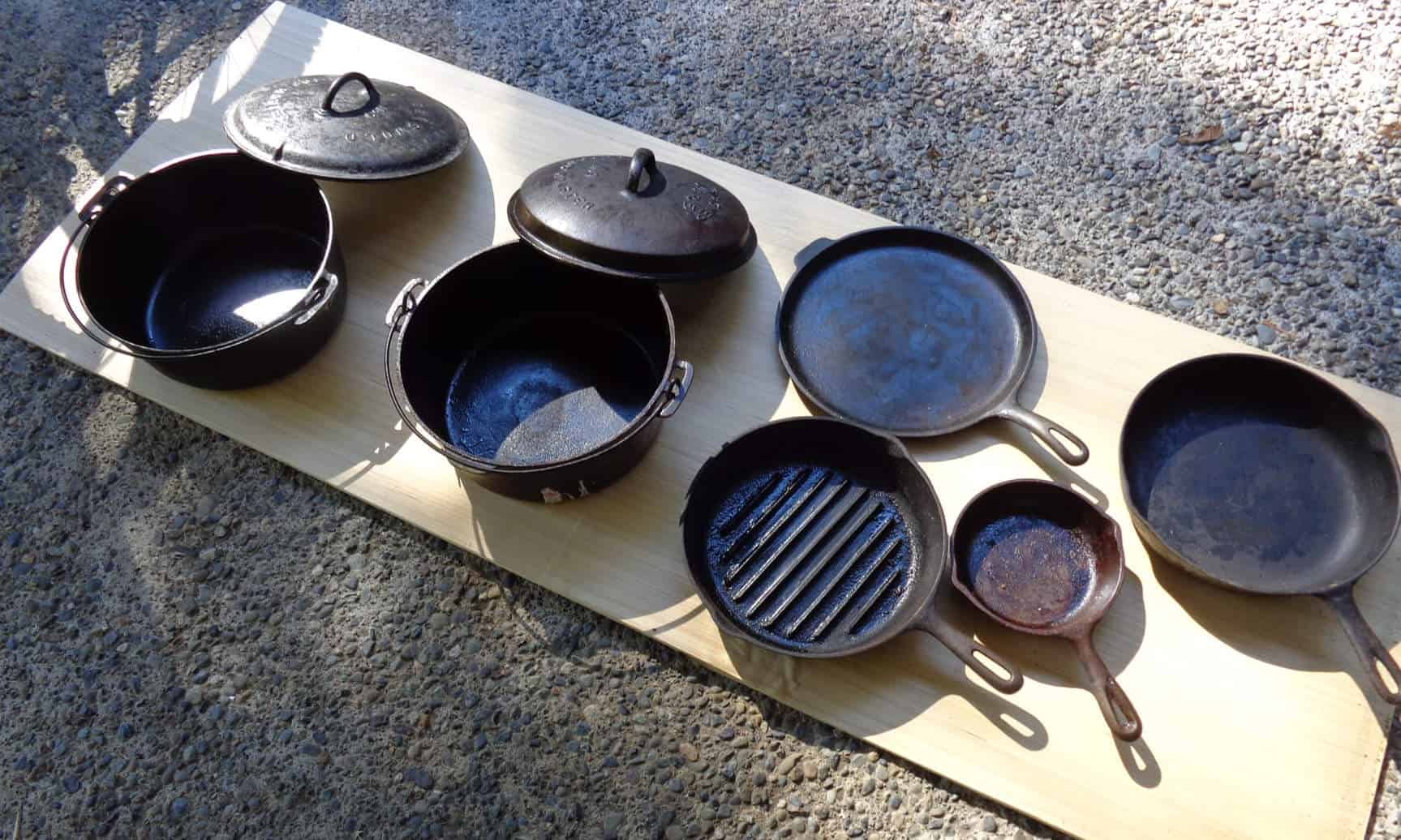
The most spread and widely popular are Griswold cast iron pans and skillets. They are a synonym for mouth-watering crispy food. The reason is that they are basically non-stick pans that can endure the high temperatures necessary for frying.
However, they are not the only popular and highly appreciated items that Griswold offers. You can also find Griswold iron cast pots of different sizes, skillets, grinding mills, Dutch ovens, and waffle baking irons.
All of them are antiques, and you can either use them for cooking or display them for the exhibit. Either way, they are popular cooking items that people gladly buy all around the world.
Sizing of Griswold Cast Iron Cooking Items
You can see different numbers on Griswold cast iron cookware. They represent various measures. The ones you can find on the handles show the size of the pot’s bottom diameter.
Keep in mind that people used wood stoves with openings mainly made for this cookware. Therefore, the diameter is a measure of these openings. The stoves changed over time, but the skillets and pots didn’t. So, the numeration stayed the same as it used to be.
The recommendation is to use your ruler to detect the pan or pot’s actual size as they can be different from the bottom to the top. For example, the mark for a 12-inch Lodge skillet is L10SK3, not a Griswold skillet. According to the manufacturer, the L10SK3 is fitted with the number 10 stove opening. Therefore, you should measure the desired cookware yourself and buy it accordingly.
Summary
The value and practicality of owning an original Griswold iron cast item will pay off once you start using it. It is a valuable part of the American people’s heritage and history, but you can also earn some money if you stumble on this type of cookware in your attic or basement.
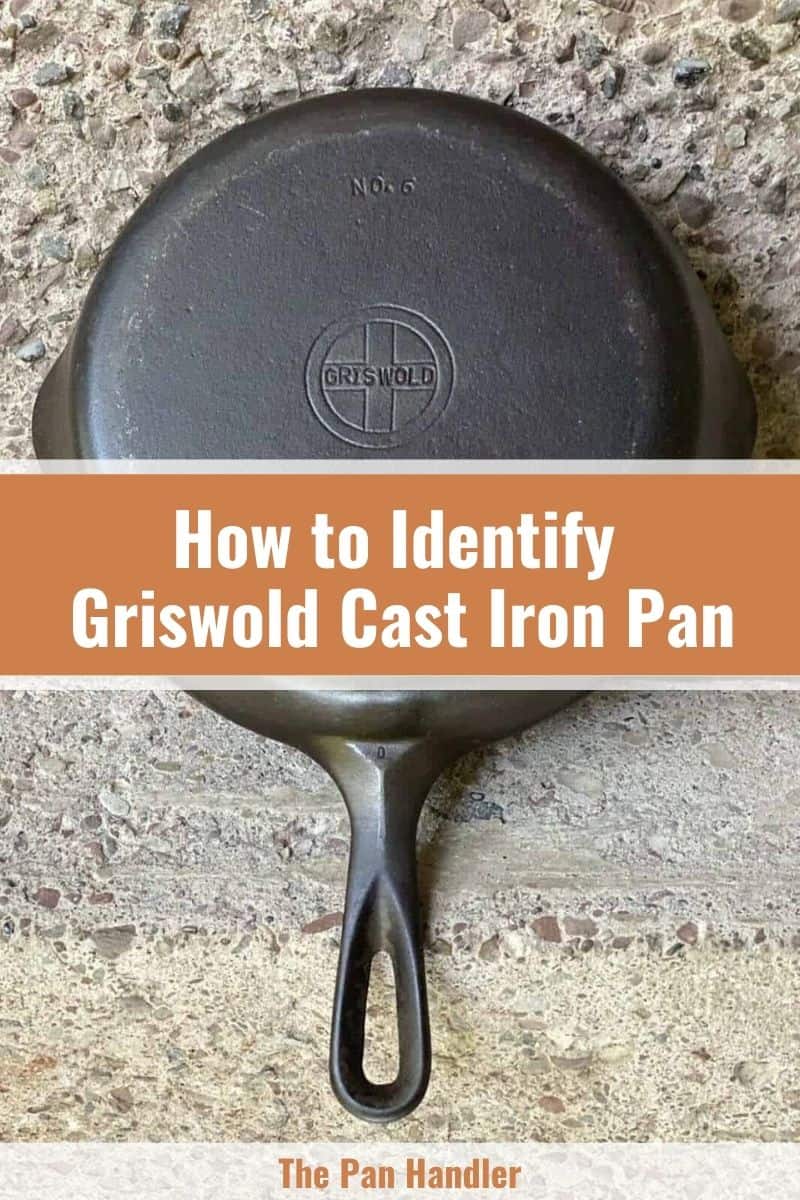

Michael Johnson is the founder of Pan Mastery, Inspired by his blacksmith grandfather’s legacy has a deep appreciation for hand-crafted pots and pans, he provides invaluable guides, reviews, and recipes to enhance your culinary journey.

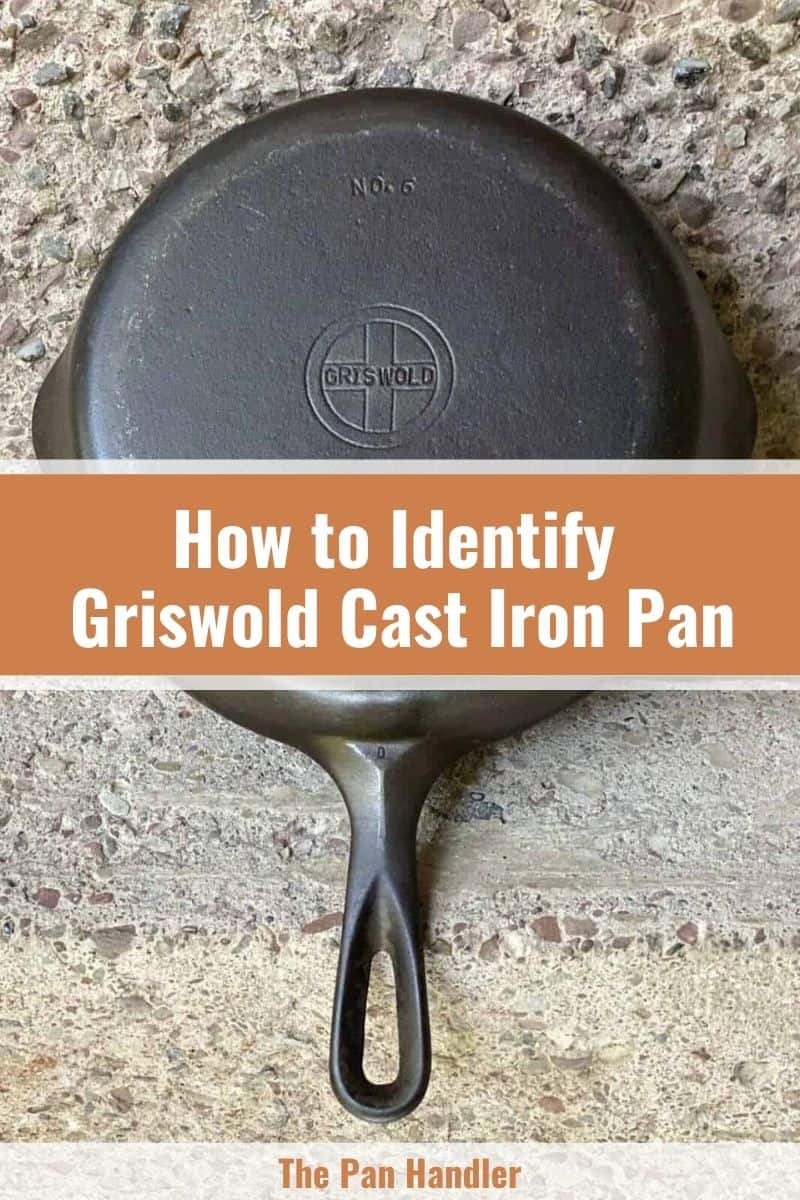









I have a Griswold’s Erie skillet. I believe it is very rare, because of the apostrophe S.
I think it is a transition piece between Erie and Griswold.
I would like to know how to determine it’s value.
I have a 3 & 1/4 inch deep cast iron pan that I bought second hand 34 years ago. It is labeled 5.5 QT, 8 with a small ‘L’ to the right of the 8 on the inside of the lid. What kind of pan is this?
I thought Griswold was the brand made in Erie PA, it did merge with Wagner, wagnered ware
Wagner bought Griswold and closed Erie plant.
I have a erie no.8 704-j gatemark
With the large logo style circle cross
The gate mark go thru the logo
Got any info on a skillet like ths
That would be recast made by some off brand company. Good cast iron quit using gate mark pour to the rim pour making a smooth bottom skillet. Big company like Griswald would sell their old molds to small company. That mold was used by ERIE (Griswald) from 1892 to 1905 for outside heat ring and inside heat ring from 1905 to1907.
did you ever get and answer about you Seldon Griswold?
Bull#hit
Hello..I have griswold cast iron skillet that was matched No.6. The only exception is that on the bottom is 704P. Anything else you might be able to tell me.
Can you check carefully if it’s a No.6, cause Griswold No.8 is 704, and the 704P was just a numbering pattern, 704 being the size of the cast iron, and the letter the mold in which that skillet was made. They would make several skillets at the same time & each mold was labelled a letter, so that they could match the skillets to the molds they were made in, in case there was a defect, they knew which mold A.B or C had the defect!
measure the skillet
No. 6 is 9 1/8 inches on the Top & 7 1/2 on bottom
No. 8 is 10 5/8 inches on the Top & 8 7/8 on the bottom
Griswold’s pattern numbering system is a little more cryptic, with the numbers appearing to have nothing to do with the size. A size #6 Griswold skillet, for example, is pattern number “699”, a size #7 is pattern “701”, and a size #8 is pattern “704”. “
I have a bean pot with Griswold on bottom and the number 6 plus under the logo is the number 788 and it Erie as well. I am wondering what type of pot it is and how old it is. Also what it may be worth.
I have a skillet marked on the back: ERIE with #7 and 701H in the center. It has a raised ring. Is this valuable?
If you want to get a feel for it’s value you may want to search eBay and see what the market is currently. I own a large collection that I’ve had for several years and I was shocked in how much they have appreciated.
I’ve got a collection of cast iron as well as axes for sale, 100 + pieces, Jeff at 507-208-2318
Can you text some pictures to (606) -5414335
I inherited an Eerie cast iron skillet #8. Just to the top right of the 8 is a small circled six-petal flower. Just curious of its value. Any info or assist?
Want to sell Dennis
It’s a makers mark, and yes valuable, I would guess 120.00
My name is Larry Fox I have a Griswold frying pan my mother gave me that’s got Erie and eight and a spider on it and I was trying to find out what it was worth and possibly selling it my father-in-law told me that he thought it might be a rare one
From what I know, the Spider logo was a logo that they used very briefly and it isn’t entirely certain why they did in the first place. It’s incredibly rare and worth a ton of money.
Is thisnstill available?
Don’t sell it. The spider symbol is rare.
Is the pan still available?
Larry,
They all are rare Griswold and Wagner, The biggest reason they couldn’t continue manufacturing was the quality standard by machining the interior surface, and the WW2. The did merge with Wagner but in time had to close shop.
The Stamp casting on bottom will pretty much tell when it was cast. Kike all antique the vale will be condition verse age, and how well it was maintained. I you see one that’s almost like new the price is un believable,,
How ever some are way over priced as owners think they have the gold one,, By the way there were several companies along with Griswold and Wagner day that also had Cast iron skillets and pots, i suggest get a catalog I believe one was called THE IRON WORKS and of course Lodge
cam along , But dot think Lodge ever machined there’s, never saw one any way,
question,i have a griswold griddle #9 with 909 one that bottom & i cant seem to find anything about it,was woundering if you mite have an idea or where to point me to see what it is worth or any info would help Thank’s Jim
Please refrain from using racial slurs
Hi Larry,
That Spider is what us called a Makers Mark. They were used to identify who was making that particular pan. Also, were used if defects were shown…again to go back to the maker. Typically, they are somewhat more valuable. I would do some research on eBay to find out what they are going for.
Yes it is. Very rare
Want to sell?
I have a question about a Griswold skillet are there any with a small emblem that did not have Erie PA on them and had made in the USA below the the cross with Griswold in the center emblem? I wish I could post a picture here.
The bottom of my Griswold looks nothing like the examples. It has the logo in the center and says “11 1/4 inch skillet,” followed by two letters I can’t read. (EI, the letter eye). What year was it made?
Keep it probably rare.
I have the same pan. Use it almost daily. I think it’s post-1957 and not rare but it works great.
1950s. That stage of production was near the end of the Griswold brand. The later pieces like that are not particularly valuable.
I have a first series “Erie” #10 and it is beautiful. I couldn’t believe how lightweight the pan was when I first used it. The quality of the casting and the heat ring means I can even grab the bare handle with my hand and it’ll be warm to the touch instead of scalding.
Any recommendations to links/stores where I could buy some great Griswold pieces.
Garage sales, and if you do not see any cast iron, ask them if they have any. I was at a garage sale and did not see any, so I ask the elder lady, do you have any cast iron pans? She said yes I do, she sent her son to the barn to grab it. A Griswold #14, she told me her mom used it one summer to cook off onions. She said 3.00 I did not have 3.00 so I gave her 10.00
A Griswold 14 small logo just sold for $2500.00!
I discovered I have an ERIE pot with a lid. The number stamped on the bottom in the middle is, I believe, 885 with the number I think 7 0 on the bottom.
If it were cleaned and seasoned it would look pretty good.
What might be its value?
I have quite a bit of Griswold, Lodge and Wagner. I have a Griswold 8, 704 that was my grandmother’s and the entire outside and the bottom appear to be chromed. I cannot find any information on this. Any thoughts on this beautiful skillet?
Yeah me too I have number 8. Bottom looks different?
There are some with nickel that only look chrome
All pictures I have seen of the Griswolds have all been smooth sided. The deep pan my Grandma gave me has a chipped look. It has the small block logo with the Erie. I cherish this pan. Lots of love cooked in that pan and that still continues.
That is hammered and worth more. Find a hammered lid for it!
What is the value of a #9 griswald 710 H skillet
When did Griswold start putting made in USA on bottom of pans? Thanks
I have a 12” cast iron skillet and it is marked 14” skillet on the bottom. What can you tell me about it ? It also has a B on the bottom of the handle. Wish I could send a picture of it
The markings you describe identify it as an unmarked Wagner. Pre 1964. The ones produced post 1964 have Made In The USA marking on them. If it has the number stamped on top of the handle it was most likely produced between 1945-46 and 1964. If it doesn’t have the number on top of the handle it was produced earlier. Also, be aware that this could be a copy of one of the variants that I listed above, many copies were made that came from China, Taiwan etc., but most of those do not have the small letter stamped at the 6 O’clock location and on the bottom of the handle.
I am interested in learning anything you can tell me about my 7″ tall X 10 1/2″ diameter Griswold pot. It has a ring on one side, a bail, lacks a heat rim, and is marked as follows on the bottom: 9 at the top, circles and cross with slanted GRISWOLD in the middle (outer circle about 3 1/8″ in diameter), “ERIE” below that, and 812 at the bottom. I did not see any ERIE in quotes in any of the photos you presented and I am curious about what significance, if any, this variant in marks might have. Just made Ham Bone Potato Soup in the pot and it was great! Many thanks. Eloise—
Hi Eloise, I just received the very same pot from a friend who found it at a Mountain Man Rendezvous! I don’t have the lid to it tho’ and am looking for one.I’m going to watch and see if anyone has answers to your question abt the Erie in quotes. Thanks
The spider logo Erie is the most rare and in some cases had sold for upward of $10,000. I have an Erie #9 from the Kate 1800’s and an early Griswold #9 1906-1916 era. The Erie #9 is thinner and therefore lighter. I imagine that Griswold started making their pans slightly thicker to keep them from cracking or warping. Both pans are amazing. I use them to sear steak and fish.
To the person who owns the spider logo, my advice is to hold on to it if it has have sentimental value. If it doesn’t, sell it and get an 1800’s Erie for way less money. There isn’t enough of a difference in the pan itself that allows it to cook better. Nothing. It’s just that they only made a few of those and they are extremely rare. Best of luck everyone!
i have a hammered gfiswold 5″ with lid no 20135 and
im looking for 2013 the 3″hammered
willing to trade buy or sell
please contact me
I have a ‘2’ griswold pan, block logo, heat ring, style looks to be from 1920-1930 time period. The 2 is stamped on the back of the handle. I can’t find any mention of a 2 from this time period, though I do see 2’s from earlier than the 20’s. Anyone aware of the potential value for this? Thanks!
I have a “ERIE
? Scotch kettle
Can’t make out
(LTo ). MAR
with a 2 like figure on the bottom
Where can I get info to identify it?
I have a Griswold 701 that was my grandmothers, she made the best burgers in this pan!
Does anyone know what pan the Griswold hinged cover fit on?
I have a Number 0 cast Iron Griswold, #562 with a heat ring. It’s very cute; no pitting.
I’d like to sell it. What would be a fair price?
hello I have a griswold no.0 and 909 waffle maker.I don’t know anything about it.Anything I could fnd out about it [ date value etc.]would be really appreciated.Thank you very much DAVID
We have a saucepan with a lid. The sauce pan has griswold on it . Is it very rare?
I have a deep cast iron skillet with the small Griswold trademark. It is stamped with a NO. 80 above the trademark, the only other stamped symbol is a large 8 on the top where the handle necks into the body. As the is no stamped Erie PA, the bottom is flat with no heat ring. So the question is, is this a real Griswold or counterfeit?
Randy, I have one also and can’t find any information. Did you ever find out anything? Mine also has a ” lip” around the top of the skillet and a notch that sticks out opposite side as the handle. Self basting skillet?
Love the interest of cast iron Griswold, Wagner, etc., I’m so glad I found this site! I will be checking even more closely on our pot collections now! We have some Griswold, Wagner and others… As well as a big collection of huge Jambalya pots….. Louisiana
Thanks!
I have a Griswold waffle iron and I have not been able to find any information concerning that product. The waffle iron is probably 100 years old. I want to know if they hold any value as the frying pans do. The waffle iron has a large square block Cross on each side of the press which sits over a hollow stand.
I have a beautiful aluminum pitcher that is marked Griswold Erie, PA USA. Small block lettering in the cross. I cannot find any info on it. Can you help? thanks in advance
I have a Griswald #9, no heat ring, with Griswald in a cross in center bottom. Also, says Cast Iron Skillet across top and ERIE, PA., U.S.A. and 710 S at bottom. I am trying to determine the age. I inherited it from my mother but don’t know if it was hers originally or belonged to her mother. If anyone can help me ‘date’ the skillet, I would be so grateful. It has a nice self basting lid and makes the BEST roasts! Will never part with it. We have four sons who all cook and it will stay in the family, for sure. Thanks again for any and all information.
Q: ‘ have top to a Griswold Chicken Fryer. logo is inside center basting ring, post WWII. Above
center logo ring SELF BASTING, below center ring looks like an 8. All marks are very difficult
to read. They seem to be covered with a gray residue. It is very difficult to remove. There is
an oval decorative area cast under handle. Very fine casting of handle and top. Can inside of
top be cleaned (stripped) to reveal markings? ‘ have tried Oven Off with limited success.
Suggestions ? Thank you.
John
In what era were waffle makers made with no logo but just the name Griswold in small letters on the base where the handle meets the frame?
wonder if you got any replies? We have the waffle maker, no base, just the name Griswold Mfg. Co. Erie PA U.S.A. Pan No 2148 and the other side is marked possibly 2149 although maybe it, too, is 2148. Trying to determine a value.
I have a very nice Griswold #80 1103A, which appears to be a cover. Can anyone tell me what number the bottom pan is supposed to be for this cover?
I was givin a griswold no ten cast iron tite top dutch over this is what the top says the underside of the lid says griswold inside of a cross patented feb 10 1920 erie pa u s a 2553 with a capital a under the 2553 after further in spec the the pot on the bottom says wagner ware sydney -0- round roaster 1270 c i was curious if this hurt the value with them being different the lid fits tite as a glove ?
I need to revise my last post on the pot it also says round roaster and the number On the bottom is 1270B not 1270c im having a hard time finding this pot and number to compare it and get a value thanks
I have a griswold number 502 outdoor 2 burner gas cooking plate. I am trying to find replacement parts for the gas orifice and handles. I would also like to find a catalog or a parts list for the 502
i have a pan “erie” “8” with a spider on the bottom curious as to its value nice condition
I have a Griswold pot and it doesn’t fit the guide you have put up. (The guide is great by the way.) Large Italic Logo, no heat ring, marked “Erie” with a 9 at the top and 834B at the bottom. Any guesses if it is rare?
I have a large iron meat grinder marked Puritan III and wondered if it was a Griswold or if anyone could tell me the approximate age. I’m 70 and still using it quite often. While I was cleaning it and putting it away today, I wondered just how old it might be.
I have a Griswold SKILLET GRILL 8 3/8″ diameter. Has GRISWOLD on a bar through the center circle instead of being open like ones I’ve seen on ebay. Rare that they are? Back has skillet grill, erie, pa.. u.s.a. patent applied for on three bars, all in caps.
Looking for a #14 skillet lid
Eldon,
I have a #14 Skillet lid for Griswell.
Low dome / profile in mint condition.
Please feel free to reach out to me!
I have a square aluminum box that looks like an old fashioned charcoal grill or smoker. It has Griswold Erie, PA. stamped on the bottom. Anyone ever heard of anything like thus?
Hello I have a Griswold #8 non heat ring, which matches the picture of the 1930-1939 skillet however it has a wooden handle with eye ring and 726 A. Any other information would be great. Thank you
I have an oval Griswold Erie PA #15 1013
I have an Oval Griswald skillet. Markings:
Top- No 15
Words OVAL SKILLET
Griswald within a cross.
Erie, Pa U.S.A.
At the bottom 1013
Any thoughts?
I have griswold #13 skillet with #720 on it. It is chrome plated. The bottom of the skillet is in the dates of 1920-1930. Can you tell me anything about it plus what it might be worth. Thank you and God Bless You. please reply.
I have a chrome plated #13 griswold #720 cast iron skillet. From your chart description, it was made from 1920 – 1930. Could you tell me anything about it and approx. how much is it worth. Is it very scarce or is there a bunch of them. Thank you for what amount of information you can give me. God Bless You. Jim Smith
i just bought a chicken cooker pot with lid the lid has a big star on it and in the middle has the cross with 4n1 horizontal and vertical is it worth any thing i am cleaning it up now
I have seen two different handle types on a Griswald #0 at eBay. Is there fakery out there, or did the handles change over time? The logos match perfectly.
Thank you,
Mike
I have an 8″ skilled just marked “Made in USA” and the number 8 on the back that was my mother’s. Is this an early Griswold?
I also have a Griswold Plett skillet marked Griswold #34 2980A. Have never seen another one.
Any idea of value on either of these?
I have a Griswold MFG Co. Erie PA spindler for stove has 553 and has American no 2. Odd shape- like an airplane, 7″ long abt 4 1/2″ at widest part slims down to 1″ wide. Most of the ones are round that I have found.
I have one wall in my kitchen with my precious cast iron, mostly of a run down of sizes of the large block Griswold.
Anyone have enamel pans? From all the info here (thank you) its a Griswold #4 Cast Iron Skillet 702 A. Small block logo Griswold (1939-1957),Grooved Handle
Double spouted but its Yellow on outside, inside pan is white . No chips or scratches, all ones I see on ebay have scratches. Was there an yellow – white enamel?
I have a Griswold No. 2 meat grinder and it says Erie PA on the back but does not have the cross logo I see on most others. Is this important? Is it older, younger, have any value? Thank you!
I have a erie in small lettering with
704-j with a gatemark no.8
And can not find any info on this cast iron skillet.
Also the erie is like closer to handle on bottom side
Hi,
I was just given a griswold cast iron skillet with the number 3 on it at the top. then under the markings it say Erie, PA U.S.A and under that is say 709 with an A under that. Im trying to find out if it has any value.
Thank You Sue
I have a Griswold#13 skillet very rare. Any serious offers
Hi Richard,
How much are you asking for the Griswold #13
Do the Dutch ovens have similar markings? Valuable or not for the below? Have one – the lid says “Griswold No 9” and then “Tite-Top Baster” along the bottom. The pan itself has very little visible markings – it’s very pitted. At the top or bottom (depends how you look) – it looks like it could be a larger but faded “9” or “6”. Lettering on the other side but too faded. The pitting is very bad and goes across 80% of the bottom.
I have Griswold #3, #4, #5, #6, #7, #8, #9 and #10. They all are Griswold slant logo “ERIE” with heat ring. These skillets are highly collectible and valuable heirloom pieces.
Please lmk if you are interested in these vintage (1906-1912) cast iron skillets.
Thank you. Michael
I don’t have any Griswold ironware.
I have a #12 that has GRISWOLD right below the heat ring then it has 12 and below the 12 it has ERIE & below that it has the cross with GRISWOLD slanted. Under the logo it has ERIE again & below that is the number 719. I’ve searched eBay & many more sites online & can’t find any like it! Do you have any suggestions? I would like to know the time period it was made & possibly the value of it!
I have a cast iron Kettle that says Erie at the top of the bottom then it has Maslin Kettle then The Griswold MFG Co Erie Pa then the number 937 then at the very bottom says 6 quart is it worth anything
Greetings… i see no mention of Griswold DuoChrome pieces.
Am curious as I have a 14 (with lid) that has this finish. Looking at eBay and Worthpoint, I haven’t seen anything similar.
Are the DuoChrome pieces very rare?
Thx,
SWD
i have a double skillet bottom, 80, erie. pa., u.s.a. 1102. i think a large block logo (not totally sure, but looks like) any ideas??
Chris: I have the same thing, a 10 inch pan that is about 3 inches deep. I would like to know when it was manufactured. Have you learned anything about yours since you posted?
I have a Griswold #5 red and cream porcelain covered skillet. Based on the article, and the logo, it would be from 1939-1957. I do not see anything about the porcelain covered Griswolds. Do you have any information on them?
Please contact me
looking.for.a.buyer.for.erie.8.spider.skillet.in.excellent.condition.
Would be interested. Pictures would help.
I came across a couple small roll pans. Told they were “RARE”…. No wear on them. Whomever had them took great care of them. A little leftover dough in one yet other looks amazing….looking for a value…. Yes, two #17’s….
17 GRISWOLD
ERIE PA.,
6140 U.S.A.
I have a Griswold #13, milled botttom, and cooking surface. It’s in great condition.
The name “Griswold” is located under the lift tab opposite the handle.
I have tried to read the pattern number, under the handle, but it’s faint,
and tends to look different when viewing at different angles.
I could say it’s “666”, but I cannot say it’s a “733”.
I have a fry pan that has the griswold making on it but I do not think it is cast iron. The handle may have been wood with a metal inner core. On the bottom it has the griswold making in the middle at the top it has a 9. On the bottom it has a A999 and under that it looks like the word special. I have had this pan for over 40 years. Was this made by griswold.
I have a Griswold cast iron pan
#9…710J
Understand it’s from 1934 to 1957 give or take. Do you know the value of this pa
Can anyone tell me the value of the pan with the the only markings being on the bottom of the pan; ‘ERIE’ on one side and 12 on the opposite side —no other markings on it. No makers or obvious gate marks, and no product no. 12 only appears on the bottom not the handle. Has a heat ring. I am planning to sell it and I don’t know if the pan is of a certain ‘run’ during the first stage of production–or even if that would be how you describe it to begin with. Lol. Any information would be appreciated! Thanks! 😊
HELLO, i HAVE AGRISWOLD #0 AND A 909 .i DON/T KNOW ANYTHING ABOUT IT,AGE OR VALUE , ANY INFO WOULD BE REALLY APPRECIATED. THANK YOU DAVID
I just bought a Griswold diamond logo griddle, with the #739 on top of the logo, and “no 9” under the logo.
No pitting, surface is smooth and flat, does not rock or spin at all.
Any idea of the value of it?
I HAVE A GRISWOLD MFG. CO. NO. 2 WAFFLE IRON 904 AND 905 – THERE IS NO INFORMATION ON THIS IN MY BOOK- CAN YOU TELL ME ANYTHING ABOUT IT.
THANKS, GARY
I have a griswold Dutch oven with the number 8 at the top of Dutch oven. It has the griswold logo in the middle of it and under the griswold logo it says Erie and under that it has the number 833 on it. On the inside of the lid it has a number 7 then it says the griswold logo and around that it says self basting pat. 1,330.209-1,554,360 then on the next ring it says 1097. I’m wondering if this is the right lid? I also have a square griswold skillet that has griswold logo on the bottom and underneath that it says square-fry skillet then under that it says Erie PA. I would like to know what these are worth?
I have a square utility skillet, #768. Also the lid, #769. Trying to find accurate info & pricing for it.
Thank you for any info.
I was given a Griswold large slant logo w/o heat ring. It is a 8 and on the bottom is only a 704 not followed by a letter, made in Erie. Can someone tell me if it has any value ?
I have a NO 8 and NO 80 that latch together to form a hi top pot. Any idea it’s worth?
My favorite hobby is going to thrift stores… last night I found 4 pieces that appear to have been maintained very well.. although still showing their age… but in almost perfect condition ..I found a griddle, tea pot, skillet and what appears to be a waffle iron of some sort.. they are all marked number zero… and they are small.. I have researched all day I believe they are authentic and I can’t believe that I found them all for under $20… The kids that mark the items have no idea… I feel like I won the lottery!!
I have some Griswold (3-10) small logo, no heat ring, probably 1950’s I want the next few sizes up, and down. All I can find is 11, 12’s….with heat rings. Do all 11, 12,…etc. have heat rings or have I just not found my year/model yet? I would like to keep them the same.
Here’s hoping someone can point me to any information about Griswold pans finished in chrome…
I believe the finish is called DuoChrome but am not sure.
Are these pans more or less collectible becasue of the finish? I have one, with lid, and have not seen that many over the years. Was this finish a gimmick?
Thanks in advance.
I have a griswold with the cross logo and under it says 11 3/4 skillet , under that made in USA handle says 10. Any info?
I have the same pan. Did you ever get any information on this pan? Mine also has the letter A stamped on the bottom under the handle.
I have a bailed 14 inch griddle with sloped shoulders . Using the information you provided date’s it somewhere between 1926 and 1940.
ebay is not an authority some will sell you something for $10.00 another will try to cheat you at a $1000.00 there are those that will overpay, and sellers that will have someone purchase the item so they can sell more at that price to those that don’t know any better. It’s a long story! Don’t get me started.eagle
I have a griddle that has the large nonitalic block logo in the middle with block letters & it says:
Cast iron griddle
9
The Griswold mfg co
Erie PA, USA
609
A
With a heat ring. Any ideas about it? It is cracked but I still use it all the time & love it
I have that exact one, no crack, but well used. The words make it different than the pictures in this article. Will be watching to see if you get any response! 😊
Did Griswold make cast iron sundials?
What about a #6 pan that has Griswold’s and ERIE on it. Most pans only say Griswold without the S on it?
I have a No 3 Griswold bought at a garage sale 2 yrs ago for $2. Rusted, neglected. It is now so well seasoned I can add 1 teaspoon of butter to it, Crack an egg in it and the egg slides all over the pan, even after flipping the egg. My new best friend in cooking for one! Logo on it appears it is the circa 1930 to 1950 series. I am blessed with this pan!!!
I have a GRISWOLD 14 CAST IRON SKILLET it has ERIE PA . , U . S . A . 718 B with heat ring in nice condition. Can anyone tell me its value?
Greetings –
Anyone out there regularly use a griswold skillet/fry pan that has the DuoChrome finish?
Thx,
Steve D.
.
I have a #9 710F Skillet and looking for a lid. What is the difference between 1099 and a 1099A? Will either fit this skillet. Outside diameter is 11-1/4″ and outside diameter pour to pour is 12-1/8″. Thank you for your response.
Know anything about the Hostess Platter from Griswold called Aristocrat Ware? Wood carry ends.
My name is Tom Hare
Just found a old waffel maker that has been in our family longer tan i can remember.
It makes 6 waffils band marked as No. 00. Can you give me any info on this piece
I inherited from my mom a 3-legged iron caldron with a handle with wood and a rind on the side. I’ve used it at Halloween with dry ice in it. I have no idea the value.
On the bottom it says :
Griswold IS (I think)
ERIE (can’t make out the rest)
T D M A R 10 T H 91
795
8
It is in pretty good condition
Hi Patti,
That’s interesting, please send the more details(the pan’s photoes) to [email protected], I will try my best to help.🥰🥰🥰
I have a red enameled Griswold, a #9 and marked 710. Based on your helpful dating guide, it fits into the 1939-1957 range
Is the enameled equal in value to the exposed cast iron?
Hi Teresa,
I need more information to make a judgment. If you could send me some detailed pictures of this pot, it would be much easier.
I have a #3 skillet and a number 709. This comes with a lid that says self basting. There is also a long Patent number. There is a number 1093. Any ideas of age and value?
I have a Griswald #8 skillet that is chromed on the outside. My parents bought it in a small-town hardware store about 1949-50 when I was a young child. I and my two sisters learned to cook in that beauty. We did everything from fudge candy and sauteed mushrooms to the best Arkie fried chicken on the planet. It is still bright and shiny on the outside and slick as a whistle on the inside and I use it often. Breaking all the rules, it was scrubbed with Babo, Comet, and SOS and was loved in the process. It is probably the only thing my two kids will fight over when I leave this place.
I have a cast aluminum oval roaster. The top says “The Griswold Mfg CO. Underneath the number 9, underneath that “Cast Alum”, in the idle they logo circle for Griswold, below that “Oval Roaster”, under that Erie PA., U.S. A., and under that A489
Can you tell me when it was manufactured?
Given these historical details, it’s likely manufactured between the late 1930s and the 1950s. For a more precise date, more details are needed; you can send photos to [email protected]
I have a Griswold Cast Iron Oval Roaster with Lid, the Roaster is a 649 and the lid is a 650. The handle on the lid has a 3/4″ break at the narrowest part. How badly will that affect the value of the set? I am interested in selling.
I have been trying to find the value of my Griswold self basting #8 lid and the #8 Griswold fry pan $704X without any luck. Would appreciate it as it is going as a gift to my Grandson. I have had it for years. Thanks for all your help. Please make sure the info goes to this address as they keep sending my email to 200 not 2000 thanks.
I have a #9 Griswold-large block type skillet that was never used with the original label, which is peeling off…. What could I glue that down with, that won’t destroy the label or the pan? The auction I was at, was an old country store, which I believe the pan never left. The price is marked on the pan with a marker 150-
I have found a griswold casserole it is an original with no enamelware on it also has the original lid any info on this would be appreciated . Also worth
I was looking around the webs for stuff and noticed this site. I have a Griswold handled deep pan. I don’t think it is a ‘dutch’ oven, but I’m not sure. It does not have a lip on the lid to hold coals. It has the Griswold emblem on both the bottom of the pan and lid. The lid emblem is barely visible. There is a 0 above the center emblem, and 2528 below the ERIE PA on the pan. Can anyone tell me more about it. I’ve been cooking with it for at least 40 years.
Have small bold Griswold in center on back. No number at top. Looks like 710 on bottom. Nothing below. 8 on top handle ????